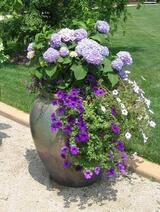
Step 1: What are You Using it For?
Step 2: Understanding Major, Minor, and Specialty Components
Step 3: Mixing and Managing
Last week we covered Step 2. So, here is Step 3. (Ward Upham)
Step 3: Mixing and Managing
Knowing what you're working with and what you're trying to do with it will help you understand how to manage it in practical use. These materials may also listed on the ingredient list and it's helpful to know what to expect.
· Lime: One special challenge we have in Kansas is that we have a lot of limestone around, which raises the pH of our soil and our water. You may notice that many bagged products include lime or limestone as a fertilization amendment. This is because most soil-less media components are very low in pH, or acidic, and they're trying to get the mix to be pH neutral (so that most nutrients are available for plant uptake). In Kansas, most of our soils are on the high pH, or alkaline, side. It is to our advantage to apply soil-less products that are low in pH because that will help to neutralize our native soil. We don't need the added limestone, but it's unlikely you'll find a product that doesn't have it mixed in. For sure, don't add more!
· Fertilizer: As mentioned earlier, most bagged products have a "starter charge" of fertilizer. You won't need to add anything immediately, but within a few weeks you'll need to apply a water-based fertilizer (immediately available to plants) and/or a long-term slow-release fertilizer product. These usually come rated for months of use. A short-term product (3-4 months) may sound like it will last all summer, but if it gets really hot outside the pellets may release early (if temperature is the mode of operation). Combining a shorter-term product with a longer term one (8-9 months) may cover your needs for a longer time.
· Wetting agent: Some products, like peat, are harvested and packaged in a very dry state and may need help retaining water when ready for use. This will likely be pre-mixed, though if you can tell it's very dry you may want to spread it in a wheelbarrow and mix in some water (and maybe your own re-wetting agent) until it's consistent.
· Watering: Containers will need to be monitored for water more frequently than landscape beds, but they all need to be checked. This will vary in every situation, so you'll need to keep an eye on it until you understand how all of the components are functioning together.
Potting media products are remarkably similar once you get past the packaging. Read the ingredient label (just like in the grocery store), find what you need for your application, and then choose the product that best meets your needs and your budget. Choose on price only after you've leveled the playing field of similar products.
Got questions about an unusual component? Let me know—I love a good alternative material discussion. (Cheryl Boyer)
 RSS Feed
RSS Feed
